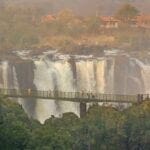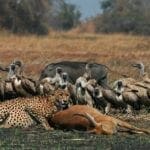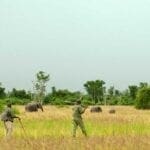Lower Zambezi National Park is becoming one of Zambia‘s greatest attractions. Being relatively undeveloped; its beauty lies in its absolute wilderness state. The diversity of animals is not as wide as the other big parks. However; the opportunities to get close to game wandering in and out of the Zambezi channels are spectacular. The Park lies opposite the famous Mana Pools Reserve in Zimbabwe. Making the whole area on both sides of the river is a massive wildlife sanctuary.
How to get there? Scheduled flights operate from Lusaka, the capital of Zambia; Livingstone, and Mfuwe in South Luangwa.
The Lower Zambezi National Park covers an area of 4092 square kilometers. However; most of the game is concentrated along the valley floor. There is an escarpment along the northern end which acts as a physical barrier to most of the park’s animal species. With the mighty Zambezi River on the other. Lush channels branch from larger rivers and weave through ancient forests. Creating a haven for wildlife and birdlife. Wide-open pans and tranquil riverbanks create a backdrop for dramatic wildlife action.
The vegetation in the area is dominated by Acacia albida trees; called the winter thorn. They grow 10 to 30 meters high, with a classical shady umbrella canopy. It is able to tolerate sandier soils than other woodland species and serves to stabilize infertile sandbanks and reduce erosion. Winterthorn pods are also remarkably nutritious to elephants who digest them leaving about 40% intact; thereby ensuring its dispersal.
Safari Activities in the Lower Zambezi National Park
Enormous herds of elephants, some up to 100 strong; are often seen at the river’s edge. ‘Island hopping’ buffalo and waterbuck are common. The park also hosts good populations of lions and leopards. Kudu, zebra, and crocodiles, and occasionally, roan, eland, and the Samango monkey. Nocturnal animals here are hyena, porcupine, civet, genet, and honey badger.
The birdlife along the riverbanks is exceptional. Many a fish eagle can be seen; and heard for miles around. White-fronted and carmine bee-eaters nest along the cliffs. Other unusual species are the red-winged pratincole, the elegant crested guinea fowl; black eagle, and vast swarms of quelea. In summer the stunning Narina trogon makes its home here. Other specialties are the trumpeter hornbill, Meyers parrot, and Lilian’s lovebird.
Fishing (tiger fishing) is a must and the lodges usually provide this as an activity.
When to visit Lower Zambezi National Park
Due to the river levels most of the camps and lodges are open from the April until around the middle of November. Although a few can still operate all year.
The best time is mid-season from June to September. During the driest months of August to November; the wildlife congregates along the river. Boat cruises are excellent all year on the Zambezi River; expect plenty of hippos, crocodiles, birds, and elephants.
As the summer rains recede; April is the best time to see wild dogs. There is also a high bird diversity. The peak walking safari season is from July to October.
Fishing is at its best from September to March; especially Tiger fishing; on a catch and release basis.





















